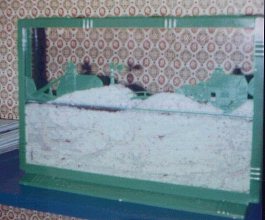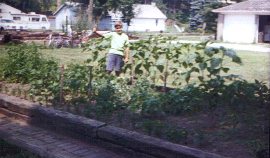.
 . ...Our Mini-Unit On Ants
. ...Our Mini-Unit On AntsIn preparation for our ant unit, I ordered the Giant Ant Farm from The Sycamore Tree! When it arrived, we set up the farm, sent for ants via U.S. mail, and waited patiently for them to arrive. We were certainly excited the day we received the ants in the mail!

Of course it's hard to see the ants in this photo. There are several underground, and you can just barely see the tunnels. But most of them are just to the left of center, in that gap where it is dark. They must be having a meeting!
After a day or two of adjusting to their new surroundings, the ants got right to work digging their tunnels. The kit came with a little book, Uncle Milton's Ant Watchers Handbook. That Uncle Milt, he sure knows his stuff! He gave us a lot of good information about caring for ants. He told us not to start a war. He said that ants are very loving with one another in the same colony, but they will fight with those from another colony. He said, "Don't ever mix your ants up or your will start a war!" Well, do you suppose saying that to an eight-year-old boy would arouse his curiosity? It sure did! It didn't take long and he was determined to see if it was true. The ants we received were rather small. Michael went out and found a big black ant in the yard. Well, I sat by with tweezers to rescue the poor fellow if anything happened, and we dropped him in. Those little ants went wild. All activity stopped while they had a war with this big guy. At first, it was fascinating, then I saw that the big guy was no match for the little ants. Just as I was trying to maneuver to get the big ant out, they moved him where I couldn't reach him! They fought him to the death. Then they threw him on their garbage heap! Michael and I looked at each other and nearly cried. We killed an innocent ant! We were ashamed of ourselves for not listening to Uncle Milty.
Uncle Milton has another book, too - Questions and Answers about Ants. We read this book as well. Once you've read Uncle Milton's books, you certainly know a lot about ants!
Then I found this most wonderful old book in our library! The Wonder World of Ants by Wilfrid S. Bronson, copyright 1937. There is fascinating information about ants in this book. If I remember correctly, much of it is told in a "story" format rather than just facts and information. I do remember we both felt it was one of the best information books we'd ever read. Here are the chapter headings
The author sure knew what she was doing by putting army ants at the last chapter! We were building up to the climax! We were astounded to find that there is one type of ant in the world that eats meat! Animals! Even a human! The people have to sleep with the legs of their beds in cans of gasoline so that the ants will die if they try to climb up the can to the bed leg and up into the bed. But they still have to be careful that their blankets don't drag on the floor, or that the ants don't climb the walls and drop from the ceiling! I no longer have this book, or I would simply quote from it, but I do think this type of thing happened only every so often when the ants were marching - they devoured everything in their path. If you can find this book, it is wonderful!
Other than observing and feeding, we didn't do a lot of activities with this ant unit. I suppose we just didn't have our hearts into it after the war! But we did do one activity that was fun! We went sugaring for ants! First we made a batch of bait by taking two rotten bananas and mashing them on waxed paper. We mixed in 1/4 cup of granulated sugar. We then went out to a tree along the sidewalk (the one furthest from the door!) and we smeared our bait on the tree trunk. We then settled down in lawn chairs with notebooks and magnifying glasses in hand to wait for the ants! Well, we waited ... and we waited ... and we waited some more. We started doing probability experiments to see how many cars would run over the piece of chewing gum someone had launched into the street. We practiced some skip counting and singing names of countries. We chatted with the neighbor. We finally gave up and went on to other things. About an hour later Michael came running in - he was VERY excited. I went out to the tree with him, and sure enough - the ants were there - tons of them! It looked like several different colonies had arrived. And what we read was true! They took a straight path to and from the bait to their colony! It was really neat to watch! And I'm sure people wondered what we doing on our hands and knees, out by the tree, looking at the ground with magnifying glasses. We felt bad again afterwards though, wondering if we gave them tummy aches with all that sugar!
I want to tell you that we were disappointed that our ants died after just a few weeks. They were so active and doing so well. We loved to pull up chairs and watch them each day. We wondered if the sun in the early morning may have shined on the farm and gave them all heatstroke. We seemed to experience quite a bit of death with this unit! Well, we weren't ready to give up. We cleaned out the farm and prepared it for new tenants. Then we went to one of our large sunflowers in the garden. It always had medium-sized black ants on it. We harvested about 20 of these ants and put them in the farm. They did very well! These were the ants we finished the summer with. At that time, we then released them at the now dead sunflower plant. (By the way ... that huge sunflower ... I brought the head of it into the house one evening to take all the seeds out to put into a bucket for hamster food. I had spread newspaper on my kitchen table and was working there. I nearly had a heart attack at the critters that were unseen, but kept coming out of that sunflower! Spiders, earwigs, ants, worms and I don't remember what else. But it was a totally frightening experience!)

The sunflowers are just behind Michael in this picture. They weren't too big yet when this picture was taken.
We aren't always highly academic with our units (gee, we almost never are). We don't always draw things and/or read everything we could or should. I try to plan things so that we learn a bit from our units and have fun, too.
I'll close with an article that Michael especially liked from a 1992 Boys Life Magazine entitled:
"The Fire Ants Are Coming"
by Burt Heim
During a quail hunting trip last year in Texas, George Bush got a few insect bites that kept him scratching for days.
The President of the United States had met the mighty fire ant.
This tiny terror is named for the burning wound it leaves on your skin. The sting turns into a red pus-filled bump that itches!
One sting isn't serious, but fire ants can use their stingers again and again. And they have a nasty habit of ganging up on their victims. Mass stingings can kill animals and people.
Some fire ants are native to North America. But the one causing big problems here in the United States hitchhiked here from South America 40 or 50 years ago. It came on a freighter that docked at Mobile, Alabama. Since then, it has spread to 11 states. And it is still staking out new territory.
This is bad news, because fire ants destroy millions of dollars worth of crops each year, and they send thousands of people to doctors. Scientists are searching for ways to kill fire ants and curb their spread.
Recently, fire ants have begun crowding into electrical equipment. Some have shorted out the wires of traffic and airport runway lights. Nobody knows why these electrical devices attract the ants.
If you have fire ants for neighbors, you will see the mounds where they live. Some fields are covered with those little hills. Each is an ant city filled with thousands of fire ants.
Somewhere in the middle of the nest is the queen ant. When young, the queen and a male will fly several hundred feet into the air and mate. That is all it takes for her to produce hundreds of eggs every day for the rest of her life.
But the problem is worse than that. Fire ants have changed their ways. Now it is common for a colony to have not one, but several queens - sometimes as many as 500. With that many egg-layers, the fire ant has become harder to control.
Where will fire ants go next? Who can tell? All we know is that, when camping, it is wise to choose a tent site that those little invaders haven't claimed first!
Go back to see what else I have on my web pages...
Return to our home page...